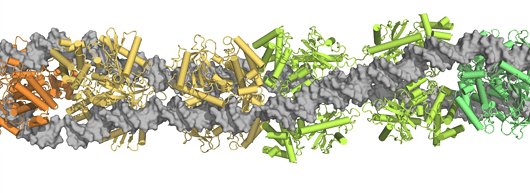To operate, insert dimers
Advertisement
The presence of DNA in mammalian cell cytoplasm triggers an immune response by binding to a dimeric enzyme, which inserts between DNA double helices to form the “rungs” of a ladder-like structure, as an LMU team has now shown.

Complex consisting of cGAS dimers and cytosolic DNA.
K.-P. Hopfner, LMU
In higher organisms, the genetic material is normally confined to the cell nucleus and the membrane-bounded organelles known as mitochondria. Any DNA found in the cytoplasm that surrounds these compartments must therefore originate either from damage to the nucleus or mitochondria, or from invasive bacterial pathogens or DNA viruses. The enzyme cGAS acts as a sensor of such misplaced DNA and “informs” the cell’s innate immune system of the presence of an infection. Now a team led by Prof. Karl-Peter Hopfner , in collaboration with his colleague Prof. Veit Hornung at the LMU Gene Center and Prof. Heinrich Leonhardt of the LMU Biomedical Center, has discovered why the length of the cytoplasmic DNA has an impact on the efficiency with which it is detected. The researchers found that the DNA and the enzyme interact to form a ladder-like complex, and went on to demonstrate that this structure must exceed a certain length in order to activate the innate immune system.
cGAS binds to cytosolic DNA as a homodimer (i.e., the functional form of the enzyme consists of two identical subunits). Binding triggers an enzymatic reaction that results in the formation of a cyclic messenger molecule that induces the synthesis of immunostimulatory proteins called interferons. Earlier studies had shown that, in cells containing equal amounts of cytosolic DNA, longer DNA strands activate this reaction much more efficiently than do short strands.
“To determine how cGAS ‘measures’ the length of the DNA, we crystallized a complex consisting of cGAS dimers and longer DNA fragments and determined its structure by X-ray diffraction,” Hopfner explains. It turns out that the complex is structured like a ladder with double-stranded DNA(s) forming the uprights between which the dimers are slotted in to form ‘rungs’. The uprights may be formed either by two separate DNAs or by a single U-shaped DNA molecule. Formation of the ladder structure is required to sufficiently stabilize the active enzyme dimers to allow them to synthesize the signal molecule cGAMP: “The more rungs are inserted, the more stable the complex becomes, as neighboring dimers stabilize one another,” says Liudmila Andreeva, lead author of the paper. “We were able to construct a mathematical model that accounts for this mechanism.”
If the DNA is so short that only a single rung can form, the complex is unstable and rapidly dissociates. “The complex functions like a zipper. If only one of the projections interlocks it can be easily displaced, but when many are slotted into place, the central part cannot fall apart,” as Hopfner explains. Certain other proteins can facilitate initiation of the ladder structure by causing the DNA to form U-turns that allow the first cGAS dimers to be inserted, which are readily followed by others. The LMU team was able to show that certain stress related and DNA packaging proteins in the nucleus, in bacteria and mitochondria stimulate cGAS activation by structuring DNA.
The researchers believe that the requirement for DNA of a minimal length, and the formation of U-turns, helps the innate immune system to avoid reacting needlessly to false alarms: Short cytosolic DNA molecules may be derived from processes within the cell itself. In order to target DNA from pathogens, it obviously helps if the sensor reacts more effectively to larger DNA fragments.
























































